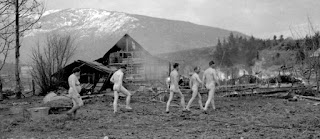US Army Command Sergeant Major Patrick J. Tadina..
Patrick J. Tadina was the longest continuously serving Ranger in Vietnam. He is one of the godfathers of the Army Rangers and is a legend within the Special Forces community to this day.
“We were beside the trail, right on the border there. We had the art of hiding down so good. I’d already counted 25 of them passing. Hardcore North Vietnamese I could barely move, except my eyes. Here came another column, brush all over them, really sneaking along — scary stuff. We had to stay so still. They were only three or four meters away now, long files of them. Just the slightest movement, and they would detect us.”
In a split second, a 5’5”’ American warrior and his five brothers-in-arms burst out of the brush like a pack of vicious wolves — but wolves armed with explosives. After the smoke cleared, these demons of the jungle melted back into the leaves, leaving a once-disciplined fighting force turned upside down and inside out, scattered and wondering just what para- normal entity had blown their columns into mincemeat.
But these men weren’t ghosts, nor were they fiction. They were Army Rangers, and they were led by the lionhearted legend Patrick J. Tadina.
In 1985, shortly after the release of Rambo: First Blood Part II, Don Tate of Stars and Stripes got one of the only long-form interviews of Tadina on record, comparing the big screen’s “Rambo” with the real thing. When Sylvester Stallone — bare chested with bowie knife clenched between Hollywood-white teeth — depicted Rambo on the big screen, he was acting.
Patrick J. Tadina was doing his duty for his country and his comrades. The real Rambo stood at 5’5”’, weighed a buck twenty-five, and spent 60 months of continuous service in one of the bloodiest wars in American history. And not a single man under his command — not one — ever fell in the line of duty. As it often turns out, fact is far wilder than fiction. Patrick J. Tadina, the soft-talking Hawaiian made out of steel and forged in the jungle heat of combat, puts his fictional counterpart to shame.
After joining in 1962 (behind his sister, one of the first women to join the Army), Tadina and a whole batch of Hawaiians were shipped off to basic training. This would start Tadina’s damn-near mythic career toward holding a permanent place in the Ranger Hall of Fame.
Tadina would never walk on the red carpet like Stallone, and he’d never win an Oscar, but at the end of his 30 years, one month and 14 days in the service (he counted), he’d achieved more than any tuxedo-clad theater major at an awards ceremony could ever dream of.
Tadina earned himself two Silver Stars, 10 Bronze Stars (seven with valor), three Vietnamese Crosses of Gallantry, four Army Commendation Medals (two for valor), and three Purple Hearts. Maj. Bob McKensie of the 3rd Infantry Division called him the most decorated enlisted man of the Vietnam War.
But what was it that made this 5’5”’ man a goliath on the battlefield? Well, his appearance for a start. Tadina had told fellow soldier Mir Bahmanyar he was of “Filipino-Chinese-German-Irish-Hawaiian descent or some exotic cocktail mix like that.”
“I looked like them,” said Tadina in his interview with Stars and Stripes. “They would see me in the middle of these big, regular-looking Americans, and didn’t know what to do. It gave us the edge. We knew what to do.” His slight build and dark complexion let him blend right in with Viet Cong soldiers on the long patrols deep into the Central Highlands of Vietnam, where he always made sure to lead from the front in the point position.
Citations describe him walking within feet of known enemies waiting to ambush and leading an enemy patrol into a trap. Guerrilla warfare was supposed to be the Viet Cong’s game, but Tadina outplayed even the wiliest of the North Viet- namese combatants, making the infamously sneaky enemies look like amateurs dropped into the pro leagues.
One can only imagine the confusion among the North Viet- namese upon seeing Tadina decked out in the company outfit — sandals, black pajamas and the AK-47 — popping out of the misty jungle hills of the Central Highlands and giving them a full metal jacket surprise. Being the best of the best, however, takes more than just a good disguise.
“We also had patience,” Tadina relayed to Don Tate of Stars and Stripes. “The American soldier is not always noted for his patience. So we learned how to outwait them. How important attention to detail was. We also knew how to deal with them in the jungle in the dark.
Dark was when Americans normally pulled inside their perimeters. Everyone said, ‘The night belongs to Charlie.’ Night was when they attacked. But, for us, it was easier at night. If you had your stuff together, you could really do it to them at night. They didn’t expect Americans to come at them at night.”
And just who, or what, were these Army Rangers? “[T]he units I was assigned in were all combat units. ... And we’re in the field and behind enemy lines and usually what our missions call for is we spend anywhere from two days to six days in the field and then we get pulled out after we accomplish our mission ... unless we get run out by the bad guys.
We were the intelligence people at that time during Vietnam.” Tadina’s brothers-in-arms of the 173rd Airborne were almost always outnumbered in the field — that’s the odds you’re up against when you’re neck-deep in hostile waters. Two dozen to one was just standard practice — but they were always one step ahead of their killer competition.
By the end of his five-year streak of jungle dominance in Vietnam, he’d personally sent at least 136 enemy combatants to the afterlife, always quick to cite his men’s lives as the fire that powered his engine of war. The actual toll is undoubtably higher — keep in mind that the Rangers were experts at pinpoint airstrikes and artillery bombardments against any Viet Cong unlucky enough to run into them.
One story told by Mir Bahmanyar on his blog, originally told by Roy Boatman (a deceased Ranger who served in Vietnam) was that Tadina snuck into an enemy hospital to attempt to break out a POW. He quietly took out a guard with a silenced .22 but found the hospital deserted. “Talk about balls and trade craft,” Mir Bahmanyar said breathlessly.
Even though Tadina was like a guardian spirit to his men, never letting a single one come to lethal harm, he himself felt the sting of bullets more than once.
“I was shot three times, man. The first time I was shot right in the middle, about halfway up my back.” But as the enemy’s
sights locked on to Tadina, he was able to dance behind a tree and use it as a makeshift shield.
Speaking during his Library of Congress interview: “... the reason why it did not damage me too much is because I seen the guy aiming at me and there was a tree right close to me. So I jumped behind the tree just as he was shooting, and then he shot again, and the bullet went through the tree, but the tree was a good, maybe eight inches around. By the time the bullet got through the tree, it kind of mushroomed out. So it did not penetrate into my back.”
Tadina’s time with the Rangers was full of close calls like that, and while once might have been luck, the Hawaiian’s ability to risk everything and come away still breathing was a matter of skill, not dice rolls.
“And the second time I was shot, I was shot while I was running. Trying to get outta an ambush, you know, and I was shot in the back, again, not in the back, but in my butt. ... He shot me right in, you know, one of my butt cheeks and just knocked me down like somebody gave me a stiff kick.”
The third time he was shot earned him not only a Purple Heart, but a Silver Star as well, as he put himself in extraordinary danger to protect his men at any cost.
As the point man, Tadina was within the kill zone when his Special Forces senses told him something was wrong, but the enemy, apparently confused about who he was, didn’t immediately fire. After spotting the enemy, Tadina pulled the trigger and warned of the ambush to his teammates before hitting the ground and being shot in both calves. His Silver Star citation reports that he refused medical aid and contin- ued to command until the enemy retreated.
“The last time I was shot, I was in an ambush, and they were waiting for us. I shot the first two, took the first two out, then the rest of ’em, there were about eight of ’em. All of ’em start opening fire on me and two bullets, one through each leg behind ... One of ’em cracked the bone in my left leg, but the other one, the bullet just kind of cut my calf. ... When I cut my pants off, patched myself up, I looked at it and my calf was hanging down around my ankles. Oh, then I’m bleeding real bad, so I tied it up with a rag, and then I got some albumin, blood expanders and took that so I wouldn’t bleed out.”
Not all the wounds from war are phys- ical, however. During the war, his brother joined the many brave soldiers memorialized on the Wall of the Vietnam Veterans Memorial. This loss, far from defeating Tadina, only pushed him to fight harder, and while he lost his brother, he still had his Ranger family.
He always seemed most at home with his “Ranger family,” his daughter said in an interview with the Together We Served blog. “He was my dad, but he belonged to so many other people,” she said.
His final statement in his interview with the Library of Congress showed his faith in God and of his Ranger brethren. “Airborne all the way, and the big ranger in the sky is always with you. We always think about the big ranger in the sky. He will always take care of all of us.”
To read the full story and the incredible account of other amazing legends please check out the book, "Giant Killers, War Heroes and Special Forces Legends" available now on Amazon as a Paperback and eBook.
God Bless our vets!











Comments
Post a Comment